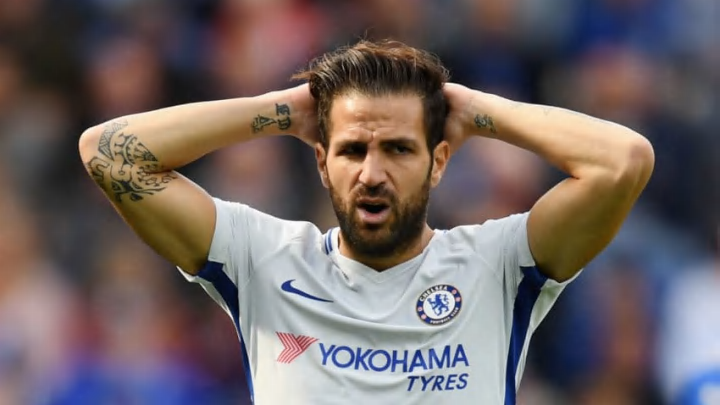Chelsea need Eden Hazard to get the most out of Cesc Fabregas in a 3-5-2
By George Perry

Chelsea played a three-man midfield against Leicester City. But with Pedro filling in for Eden Hazard, Cesc Fabregas too often drifted forward and to the left, minimizing his ability to control the run of play.
Cesc Fabregas joined N’Golo Kante and Tiemoue Bakayoko in Chelsea’s starting XI against Leicester City. On paper, this seemed to be the next step towards the long-awaited 3-5-2, where Kante and Bakayoko protect the midfield while Fabregas uses the space to create chances for Alvaro Morata and a second or shadow striker.
However, Fabregas divided his duties between the centre of the pitch and the left wing. He would be in his usual central position as Chelsea advanced into Leicester territory, before moving up and over once Chelsea took the ball into Leicester’s third. The final product was closer to a 3-4-2-1, with Fabregas and Pedro as wingers playing off Alvaro Morata.
This negated Fabregas’ ability to read the game and create the perfect pass to Chelsea’s forwards. From the left side he had neither the perspective to see the play developing nor the passing angles to deliver the ball to Alvaro Morata or Pedro.
Must Read: N'Golo Kante and Pedro at opposite ends of Chelsea's player ratings vs. Leicester
Pedro’s play in place of Eden Hazard created this problem for Fabregas. Pedro may cover more ground with his zippy loopy runs, but he does not shift the play to that space – let alone occupy the defenders’ attention – like Hazard. Hazard keeps the entire width of the pitch in play when he enters the final third. This creates new space for the other forwards – or defenders on an overlap – and for Fabregas to spot an open man when the ball comes back to him.
With Pedro as the shadow striker alongside Alvaro Morata, part of the pitch will lie fallow. Cesc Fabregas moved to fill the space on the left. But he is not a winger, and cannot use that space effectively. He will not take on a defender one-on-one, nor will he initiate a one-two that requires him to have an explosive first step. That area also does not give him the best angle for his signature passes, reducing the effectiveness of his core ability.
Similarly, Marcos Alonso did not have a vertical partner for passes or overlaps. Alonso’s main passing partners were Tiemoue Bakayoko and Antonio Rudiger. Alonso did not move forward as much as he would if he had Hazard or another winger in front of him. Fabregas and Alonso are both too slow for a one-two, and Alonso would risk leaving the left flank completely vulnerable if he ran an overlap on Fabregas.
Passmaps & xGplot for Leicester against Chelsea. #passmap #xGplot #autotweet pic.twitter.com/FR6FdS5EkY
— 11tegen11 (@11tegen11) September 9, 2017
Cesc Fabregas has nearly unlimited capacity within a limited role. He needs to be able stay central, scan and create. This means Chelsea cannot have empty spaces on one side of the final third while the opposition swarms the forwards on the other.
Antonio Conte promised Cesc Fabregas a larger role this season. So far, Conte has maintained his promise. Fabregas has started three games for 249 minutes. However, he has yet to register his first assist.
More than most managers, Antonio Conte’s system requires each player to fulfill a specific role to perfection. Conte’s sides are not plug-and-play. Fabregas’s performance against Leicester showed the mismatch between the player and the requirement. If Hazard is unavailable and Antonio Conte wants Cesc Fabregas on the pitch, he should revert to the proven 3-4-3 with Fabregas alongside Kante.
Next: Chelsea's win at Leicester exposed weaknesses at goalkeeper, creativity
Tiemoue Bakayoko’s addition gives Chelsea midfield the solidity it needs to allow Fabregas to focus on creation. Eden Hazard’s return should allow Fabregas to stay between Tiemoue Bakayoko and N’golo Kante, while Hazard and Alvaro Morata own the attacking area. That is the ideal lineup for a 3-5-2, as it allows each player to do what they are at Chelsea to do.